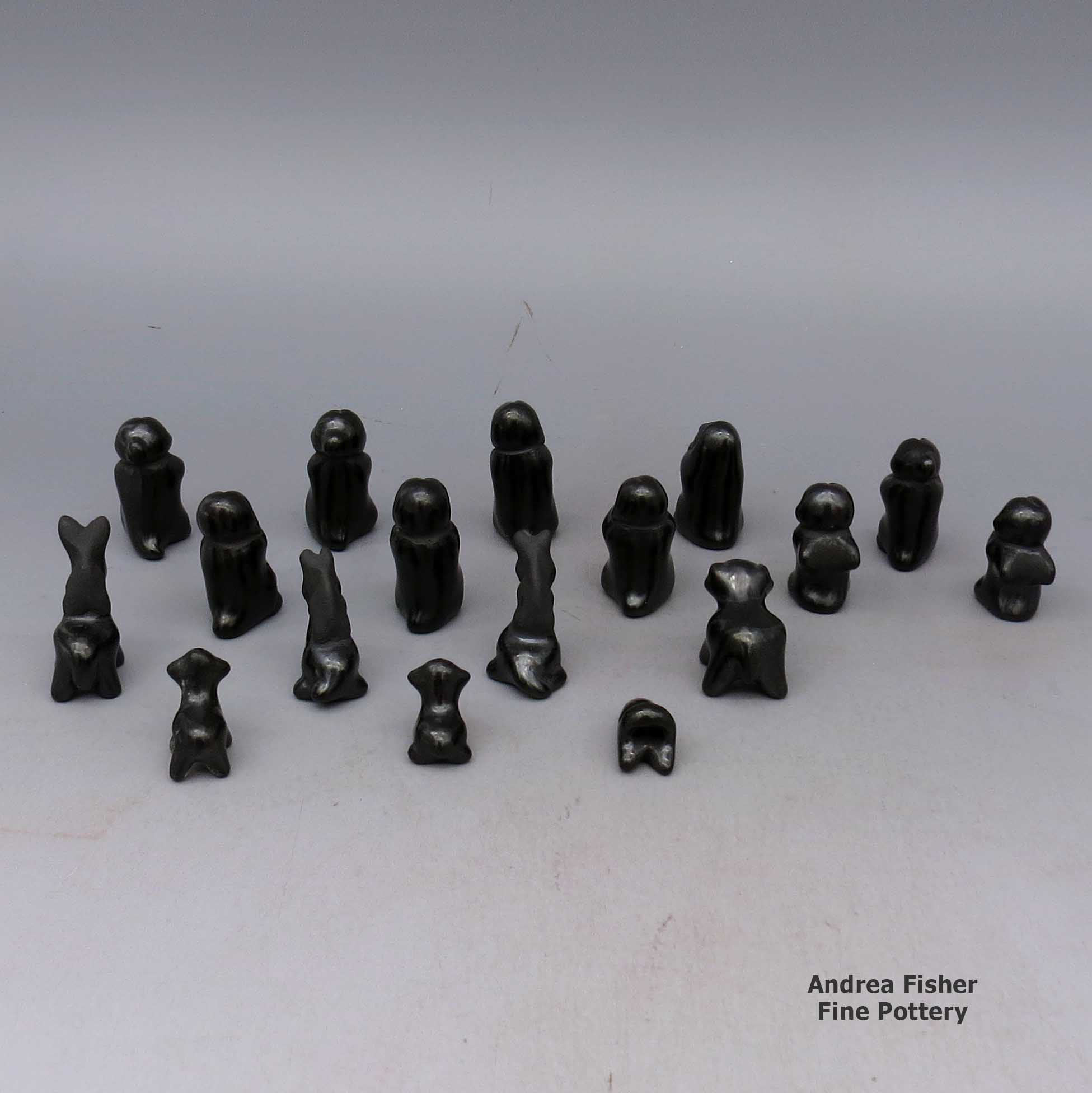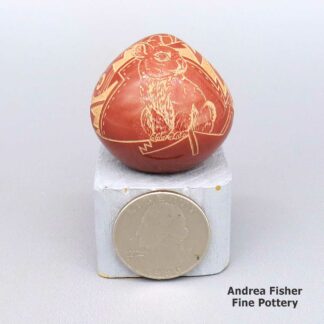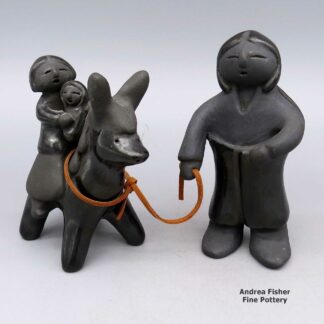| Dimensions | 0.75 × 0.75 × 1.75 in |
|---|---|
| Condition of Piece | Very good, normal wear |
| Signature | Dorothy Gutierrez |
Dorothy Gutierrez, lksc2l287: Black 17-piece miniature nativity set
$495.00
A 17-piece black miniature nativity set with figures modeled after Dineh heritage
In stock
Brand
Gutierrez, Dorothy
A Short History of Santa Clara Pueblo

Santa Clara Pueblo straddles the Rio Grande about 25 miles north of Santa Fe. Of all the pueblos, Santa Clara has the largest number of potters.
The ancestral roots of the Santa Clara people have been traced to ancient pueblos in the Mesa Verde region in southwestern Colorado. When the weather in that area began to get dry between about 1100 and 1300 CE, some of the people migrated to the Chama River Valley and constructed Poshuouinge (about 3 miles south of what is now Abiquiu on the edge of the mesa above the Chama River). Eventually reaching two and three stories high with up to 700 rooms on the ground floor, Poshuouinge was inhabited from about 1375 CE to about 1475 CE.
Drought then again forced the people to move. One group of the people went to the area of Puyé (along Santa Clara Canyon, cut into the eastern slopes of the Pajarito Plateau of the Jemez Mountains). Another group went south of there to what we now call Tsankawi. A third group went a bit to the north, following the Rio Chama down to where it met the Rio Grande and founded Ohkay Owingeh on the northwest side of that confluence.
Beginning around 1580, another drought forced the residents of the Puyé area to relocate closer to the Rio Grande. There, near the point where Santa Clara Creek merged into the Rio Grande, they founded what we now know as Santa Clara Pueblo. Ohkay Owingeh was to the north on the other side of the Rio Chama. That same dry spell forced the people down the hill from Tsankawi to the Rio Grande where they founded San Ildefonso Pueblo to the south of Santa Clara, on the other side of Black Mesa.
In 1598 Spanish colonists from nearby Yunqué (the seat of Spanish government near the renamed "San Juan de los Caballeros" Pueblo) brought the first missionaries to Santa Clara. That led to the first mission church being built around 1622. However, the Santa Clarans chafed under the weight of Spanish rule like the other pueblos did and were in the forefront of the Pueblo Revolt of 1680. One pueblo resident, a mixed black and Tewa man named Domingo Naranjo, was one of the rebellion's ringleaders.
When Don Diego de Vargas came back to the area in 1694, he found most of the Santa Clarans were set up on top of nearby Black Mesa (with the people of San Ildefonso, Pojoaque, Tesuque and Nambé). An extended siege didn't subdue them but eventually, the two sides negotiated a treaty and the people returned to their pueblos. However, successive invasions and occupations by northern Europeans took their toll on the pueblos over the next 250 years. The Spanish flu pandemic in 1918 almost wiped them out.
Today, Santa Clara Pueblo is home to as many as 2,600 people and they comprise probably the largest per capita number of artists of any North American tribe (estimates of the number of potters run as high as 1-in-4 residents).
For more info:Pueblos of the Rio Grande, Daniel Gibson, ISBN-13:978-1-887896-26-9, Rio Nuevo Publishers, 2001
Upper photo courtesy of Einar Kvaran, Creative Commons Attribution-Share Alike 3.0 Unported License
About Miniatures
Most people who have heard of it think miniature pottery has to be something new in the world of Native American pottery. In reality, archaeologists have found miniature pottery in the remains of ancient ruins in Chaco Canyon, Mesa Verde, across eastern Arizona, southern New Mexico and south to the Paquimé and Casas Grandes region in northern Mexico. Archaeologists working in the eastern US have found miniature pottery spread across Early Woodland Culture sites, too, dated up to 1700 years ago.
We have no idea as to why the ancients created miniature pottery but there's lots of speculation. Perhaps it was made as toys for children. Perhaps it was made by children learning to make pottery, and as their expertise grew, the size of their pieces grew, too. Perhaps it was made and placed in a firing pit as a good luck charm, hoping that other pots being fired in the pit would survive the firing process and not crack or break. Perhaps it was made for some ceremonial purpose we have no possibility of knowing. We do know that in North America, almost every pottery-making group of ancients made miniature pottery. They decorated it, too, just like the full size pottery the women of the time were making.
As the rebirth of traditionally made Native American pottery has unfolded over the last century, research into the ancient forms, styles and designs has also brought the miniature back into focus. There are more than a few potters these days making tiny gems again, similar to and, at the same time, more refined than the products of the potters of prehistory. And while some are still being made by children learning as they grow up, many more are being made by established adult potters. Some have made their entire careers around the making of miniatures while others sometimes make a few miniatures to complement the full range of forms and styles of full size pieces they make.
Since the advent of big trade fairs showcasing Native American pottery, the definition of what makes a miniature has evolved. In the beginning a miniature had no dimension larger than 2.25 inches. Then it was felt that that small a definition was too small: there was no competition because there were too few potters making pottery in that size range. Then one venue changed their definition to: no dimension larger than 4.25 inches, while another changed their definition to: no dimension larger than 3.25 inches. Competition for prizes in the different miniature styles rose immediately at both but it didn't answer the basic question: what is a miniature? As far as Thomas Natseway of Laguna Pueblo is concerned, a miniature has no dimension larger than 2.25 inches. And he's been making them smaller than that for more than 30 years.
About Miniatures
Most people who have heard of it think miniature pottery has to be something new in the world of Native American pottery. In reality, archaeologists have found miniature pottery in the remains of ancient ruins in Chaco Canyon, Mesa Verde, across eastern Arizona, southern New Mexico and south to the Paquimé and Casas Grandes region in northern Mexico. Archaeologists working in the eastern US have found miniature pottery spread across Early Woodland Culture sites, too, dated up to 1700 years ago.
We have no idea as to why the ancients created miniature pottery but there's lots of speculation. Perhaps it was made as toys for children. Perhaps it was made by children learning to make pottery, and as their expertise grew, the size of their pieces grew, too. Perhaps it was made and placed in a firing pit as a good luck charm, hoping that other pots being fired in the pit would survive the firing process and not crack or break. Perhaps it was made for some ceremonial purpose we have no possibility of knowing. We do know that in North America, almost every pottery-making group of ancients made miniature pottery. They decorated it, too, just like the full size pottery the women of the time were making.
As the rebirth of traditionally made Native American pottery has unfolded over the last century, research into the ancient forms, styles and designs has also brought the miniature back into focus. There are more than a few potters these days making tiny gems again, similar to and, at the same time, more refined than the products of the potters of prehistory. And while some are still being made by children learning as they grow up, many more are being made by established adult potters. Some have made their entire careers around the making of miniatures while others sometimes make a few miniatures to complement the full range of forms and styles of full size pieces they make.
Since the advent of big trade fairs showcasing Native American pottery, the definition of what makes a miniature has evolved. In the beginning a miniature had no dimension larger than 2.25 inches. Then it was felt that that small a definition was too small: there was no competition because there were too few potters making pottery in that size range. Then one venue changed their definition to: no dimension larger than 4.25 inches, while another changed their definition to: no dimension larger than 3.25 inches. Competition for prizes in the different miniature styles rose immediately at both but it didn't answer the basic question: what is a miniature? As far as Thomas Natseway of Laguna Pueblo is concerned, a miniature has no dimension larger than 2.25 inches. And he's been making them smaller than that for more than 30 years.
Gutierrez Family Tree - Santa Clara Pueblo
Disclaimer: This "family tree" is a best effort on our part to determine who the potters are in this family and arrange them in a generational order. The general information available is questionable so we have tried to show each of these diagrams to living members of each family to get their input and approval, too. This diagram is subject to change should we get better info.
- Tonita Gutierrez (1859-aft 1934) and Jose Domingo Gutierrez (1844-before 1931)
- Lela (1895-1966) & Van (Evangelio) Gutierrez (1885-1956)
- Luther Gutierrez (1911-1987) & Lupita Naranjo
- Paul Gutierrez & Dorothy Gutierrez (Dineh)
- Gary Gutierrez
- Paul Gutierrez Jr. (1966-)
- Pauline Gutierrez Naranjo (1931-) & Frank Naranjo
- Stephanie Naranjo (1960-)
- Paul Gutierrez & Dorothy Gutierrez (Dineh)
- Margaret Rose Gutierrez (1936-2018)
- Luther Gutierrez (1911-1987) & Lupita Naranjo
- Severa Gutierrez Tafoya (1890-1973) and Cleto Tafoya
- Angela Tafoya Baca (1927-2014) & Antonio Baca
- Alvin Baca (1966-)
- Daryl Baca (1961-)
- David Baca (1951-)
- Leona Baca (1958-)
- Epimenia (Mela) Tafoya (1920-1962) & Robert Nichols
- Robert Cleto Nichols (1961-) & Miana Pablito (Zuni)
- Lydia Tafoya (1923-1975) & Santiago Garcia (San Juan/Ohkay Owingeh)
- Greg Garcia (1961-2010)
- Tina Garcia (1957-2005)
- Virginia Garcia (1963-)
- Maria (Mary Agnes) Tafoya (1925-1983) & Mosimino Tafoya
- Stephanie Tafoya Fuentes (1963-) & Lorenzo Fuentes
- Alita Povijua (1957-)
- Kathy Silva (1947-)
- Gwen Tafoya
- Wanda Tafoya (1950-)
- Eric Tafoya (1969-)
- Lawrence Tafoya (1968-)
- Mary Agnes Talache (1981-)
- Charlene Victoria Talache (1986-)
- Tonita (1930-) & Paul Tafoya
- Paul Speckled Rock (1952-2017)
- Adam Speckled Rock (1972-)
- Kenneth Tafoya (1953-)
- Ray Tafoya (1956-1995) & Emily (Suazo) Tafoya
- Jennifer (Tafoya) Moquino (1977-) & Michael Moquino
- Leslie Tafoya
- Paul Speckled Rock (1952-2017)
- Angela Tafoya Baca (1927-2014) & Antonio Baca









